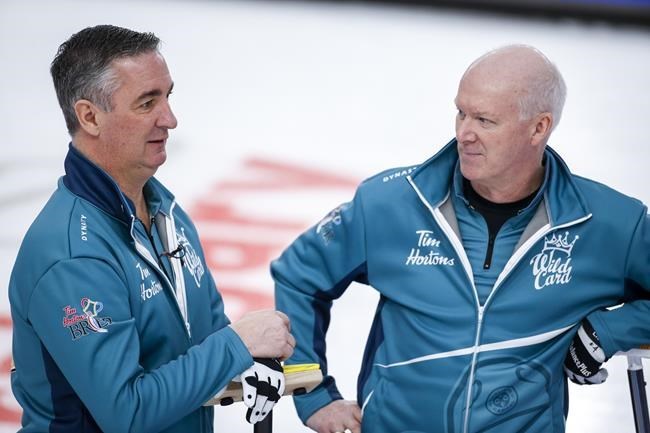In 18 career appearances at the Canadian men's curling championship, this was a first for Glenn Howard.
The longtime skip, who's serving in a coach/alternate role for Wild Card Three at the Tim Hortons Brier, planned to file an official protest with Curling Canada after his team wasn't advised that the curling stones had been sandpapered before Saturday afternoon's draw.
"I'm literally starting it off by saying that 'It pains me to have to do this,'" Howard said from Calgary. "I don't want to do this sort of stuff, but they have to know that this is a big issue.
"It's something that needs to be dealt with properly. Hopefully moving forward they'll realize this process isn't ideal and that maybe it should be rectified. We'll see."
Papering the bottom of each granite stone - also called 'touching up,' 'sanding' or 'texturing' - is done by ice technicians on site, usually a day or two before the final weekend at an event like the Brier.聽
The process impacts the rock's curl and speed on the ice. In a sport where every millimetre counts, it has a significant effect.聽
Curlers who don't know that rocks have been papered are at a distinct disadvantage because they're expecting the rocks to move a certain way.聽
Many curlers said they learned about the papering by chatting with the arena crew before the draw. Howard's team did not, and only discovered the change late in their pre-game practice session.聽
Normally curlers are advised when stones are papered, but Curling Canada admitted there was a communication breakdown.
"It's mind-boggling that the communication is not there," Howard said. "They have to be much more transparent."
The Wild Card Three team, skipped by Wayne Middaugh with Howard out due to injury, went on to drop a 6-3 decision to Canada's Brad Gushue.聽
"The bottom line is it was just a lack of communication," Middaugh said. "That's what hurt some teams and helped others. Whatever. That's the way it goes. You still have to adjust. Every game you play, the ice is different. You've got to be able to adjust.聽
"Glenn and I have played a million events together. Ice conditions change, rocks change, that's the way it is. The bottom line is we didn't adjust very well."
In a statement Saturday afternoon, the national federation said it would review its procedures going forward to address the issue.
"The rocks at the Brier were touched up late Friday night in response to player comments that there was less curl in the later ends," Curling Canada said. "At that point, there was a communication breakdown, which Curling Canada regrets, as none of the teams was officially informed that the rocks had been touched up.聽
"Two teams approached chief ice technician Greg Ewasko prior to practice to ask if the rocks had been touched up, and he confirmed to them that they had. As is customary, each of the eight teams had nine minutes of practice time prior to the game."
Wild Card Two's Kevin Koe entered Saturday night's championship pool finale in first place at 9-2. He said his team checks in with Ewasko regularly to discuss conditions and any potential changes.
"We ask him what we can expect and he'll tell us," Koe said. "He'll tell every team that if they go ask him."
Wild Card Three, meanwhile, was in a four-way tie for second place at 8-3. Middaugh said it was "a bit of an issue" that some teams knew about the sanding and others didn't.
"You go out to throw your first rock in practice and all of a sudden it curls off the sheet and it's 20 feet slower than it's been all week," Middaugh said. "The only difference is you would prepare differently if you knew the rocks were sanded.聽
"You'd go into it a lot differently knowing that. It's just what it is. The issue was we didn't know."
Sometimes humidity, ice temperature or other factors can affect the path of a curling stone. Howard's eyebrows were raised early in his team's practice when several rocks didn't make the hog line.
Minutes ticked away as they attempted to figure things out while also trying to match rocks and break down paths on the ice.聽
"Had I known, we would have completely changed our practice," Howard said.聽
After learning from other players that the rocks had been papered, Howard addressed the matter with the head official, claiming his team was at a distinct disadvantage.聽
"The bottom line is everybody needs to know," he said. "In my mind, it's completely unacceptable when you make a drastic change like that."
Howard asked that another practice session be held and that at a minimum, his team should get another chance to throw its last stone draw.聽
The LSD affects who starts a game with hammer and can play a factor in potential tiebreaking scenarios. Both suggestions were denied, Howard said.
"I talked to a representative of Curling Canada, explained the situation, and he literally didn't speak," Howard said. "He didn't give me any information. I was like, 'Wow guys, you're killing me here.'"聽
It's unclear if a protest would bear any fruit for the Ontario-based Howard team.聽
A three-person panel, which would include Curling Canada CEO Katherine Henderson, would hear any appeal and an assessment would be made as soon as possible, a federation spokesman said.
"The problem is it's too late," Howard said. "It should have been dealt with much differently at ice level. I imagine the only thing moving forward is that they fix it and that it doesn't happen again."
The top three teams will make the Brier playoffs. The semifinal and final are scheduled for Sunday.
This report by The Canadian Press was first published March 13, 2021.聽
Follow @GregoryStrongCP on Twitter.
Gregory Strong, The Canadian Press



